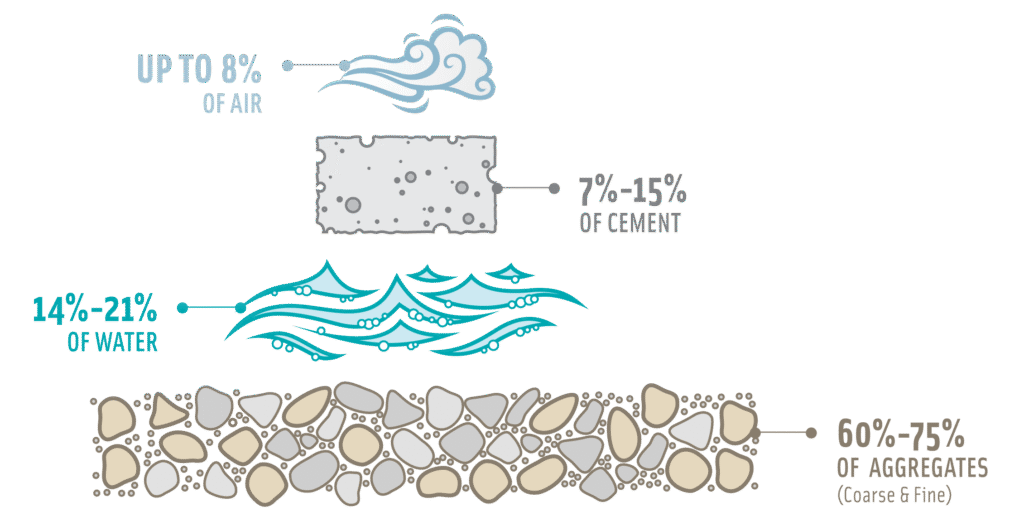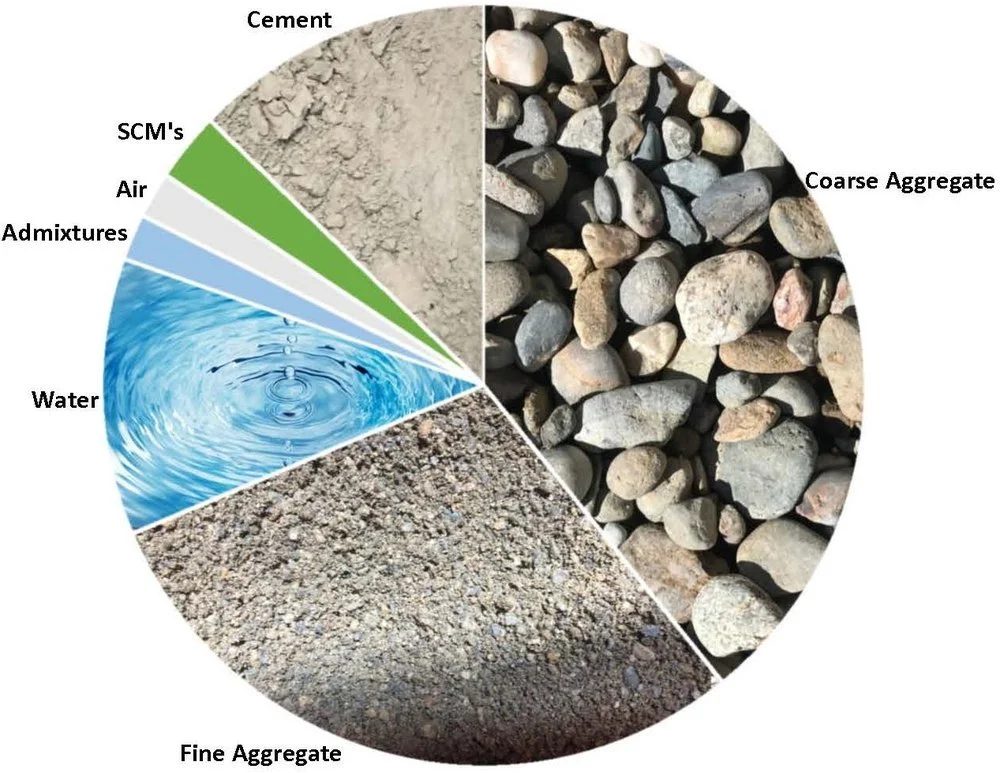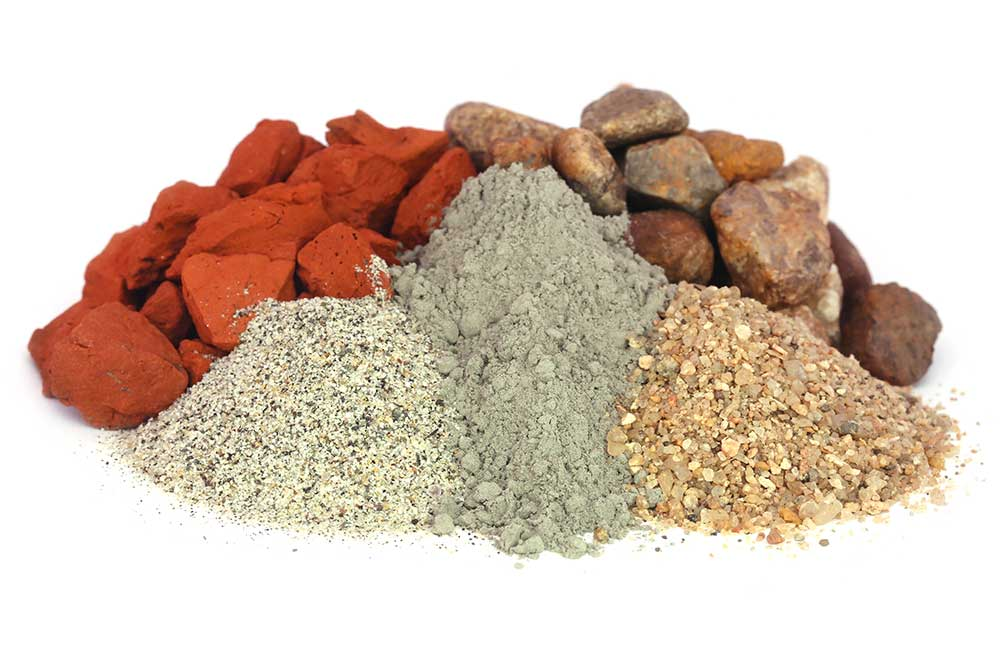Concrete. It’s the bedrock of modern civilization, quite literally. From towering skyscrapers and sprawling highways to humble sidewalks and residential foundations, concrete shapes the world around us in profound and often unnoticed ways. But what exactly is concrete? What makes it so strong and durable? And how is it made? This comprehensive guide, “Concrete 101: Everything You Need to Know,” will answer these questions and more, providing a foundational understanding of this essential building material.

1. What is Concrete? Defining the Material
At its most basic, concrete is a composite material composed primarily of an aggregate held together by a binder. Think of it like a rocky stew, where different sized rocks (the aggregate) are glued together by a pasty sauce (the binder). Specifically, concrete consists of:
- Cement: The binding agent, usually Portland cement, is a fine powder that, when mixed with water, undergoes a chemical reaction called hydration, binding the aggregate together.
- Aggregate: Inert granular material, such as sand, gravel, crushed stone, or recycled concrete, that constitutes the bulk of the concrete mix. Aggregates provide strength, stability, and volume to the concrete.
- Water: Essential for the hydration process of the cement. The amount of water significantly affects the workability, strength, and durability of the concrete.
- Admixtures: Optional ingredients added to the concrete mix to modify its properties, such as workability, setting time, strength, or durability.
Therefore, concrete is not cement. Cement is a component of concrete. The difference is crucial.
2. The Magic of Cement: The Binding Agent Explained
Understanding cement is key to understanding concrete. Portland cement, the most common type, is manufactured through a carefully controlled process:
- Raw Materials: The primary raw materials are limestone (calcium carbonate), clay (silica, alumina, iron oxide), and smaller amounts of other materials.
- Crushing and Grinding: The raw materials are crushed and ground into a fine powder.
- Kiln Heating: The powder is heated to a high temperature (around 1450°C or 2640°F) in a rotary kiln. This process, called calcination, converts the raw materials into cement clinker, hard, nodular lumps.
- Clinker Grinding: The clinker is cooled and ground into a fine powder. A small amount of gypsum (calcium sulfate) is added to regulate the setting time of the cement.
- Cement Types: Different types of Portland cement are produced by adjusting the composition of the raw materials and the grinding process. Common types include:
- Type I (Normal): General-purpose cement suitable for most applications.
- Type II (Moderate Sulfate Resistance): Used where moderate sulfate exposure is expected.
- Type III (High Early Strength): Develops strength rapidly, suitable for situations requiring quick turnaround.
- Type IV (Low Heat of Hydration): Generates less heat during hydration, used in massive concrete structures like dams to prevent cracking.
- Type V (High Sulfate Resistance): Used where severe sulfate exposure is expected.
Beyond Portland cement, alternative cements are gaining traction due to sustainability concerns:

- Blended Cements: Portland cement mixed with supplementary cementitious materials (SCMs) like fly ash, slag, or silica fume. This reduces the clinker content, lowering the carbon footprint.
- Geopolymer Cements: Cements made from aluminosilicate materials like fly ash or slag activated by alkaline solutions. They offer lower carbon emissions and potentially improved durability.
3. Aggregates: The Backbone of Concrete Strength
Aggregates, making up 60-80% of the concrete volume, significantly influence its properties and cost. They are categorized as:
- Fine Aggregate (Sand): Particles generally smaller than 4.75 mm (No. 4 sieve). Sand fills the voids between larger aggregates, improving workability and density.
- Coarse Aggregate (Gravel or Crushed Stone): Particles generally larger than 4.75 mm (No. 4 sieve). Coarse aggregate provides the primary strength and stiffness to the concrete.
Important aggregate characteristics include:
- Size and Grading: The distribution of aggregate sizes within the mix. Proper grading optimizes particle packing, reducing the amount of cement paste required and improving strength.
- Shape and Texture: Rounded aggregates improve workability, while angular and rough-textured aggregates provide better bonding with the cement paste, increasing strength.
- Strength and Durability: Aggregates should be strong and durable enough to withstand the stresses placed on the concrete structure and resist weathering and chemical attack.
- Cleanliness: Aggregates should be free from contaminants like clay, silt, and organic matter that can interfere with cement hydration and reduce concrete strength.

Specialty aggregates can be used for specific purposes:
- Lightweight Aggregates: Expanded shale, clay, or slate, used to produce lightweight concrete for reducing dead load.
- Heavyweight Aggregates: Magnetite or barite, used to produce heavyweight concrete for radiation shielding.
- Recycled Aggregates: Crushed concrete from demolition sites, offering a sustainable alternative to virgin aggregates.
4. Water: The Catalyst for Hydration
Water is critical for the chemical reaction, hydration, that allows the cement to bind the aggregates. The water-cement ratio (w/c) is a crucial factor:
- Definition: The ratio of the weight of water to the weight of cement in the mix.
- Impact on Strength: Lower w/c ratios generally lead to higher strength concrete. Less water means a denser cement paste with fewer voids.
- Impact on Workability: Lower w/c ratios also make the concrete less workable, requiring more effort to place and consolidate.
- Typical Range: The w/c ratio typically ranges from 0.4 to 0.6, depending on the desired properties of the concrete.
The quality of the water is also important:
- Potability: Water should generally be potable (drinkable) and free from contaminants like salts, oils, and organic matter that can interfere with hydration or cause corrosion of reinforcing steel.
5. Admixtures: Fine-Tuning Concrete Performance
Admixtures are chemical or mineral additives incorporated into the concrete mix to modify its properties and enhance its performance. They are typically used in small quantities but can have a significant impact:
- Chemical Admixtures:
- Water Reducers (Plasticizers and Superplasticizers): Reduce the amount of water needed to achieve a desired workability, increasing strength and durability. Superplasticizers (high-range water reducers) are particularly effective.
- Air-Entraining Agents: Create microscopic air bubbles in the concrete, improving resistance to freeze-thaw cycles. Essential in cold climates.
- Accelerating Admixtures: Speed up the setting time and early strength development of concrete. Used in cold weather or when rapid strength gain is needed.
- Retarding Admixtures: Slow down the setting time of concrete, allowing for longer working times, especially in hot weather.
- Corrosion Inhibitors: Protect reinforcing steel from corrosion in chloride-rich environments.
- Shrinkage-Reducing Admixtures: Reduce the amount of shrinkage cracking in concrete.
- Mineral Admixtures (Supplementary Cementitious Materials – SCMs):
- Fly Ash: A byproduct of coal combustion, fly ash can replace a portion of the Portland cement, reducing the carbon footprint and improving durability.
- Slag (Ground Granulated Blast-Furnace Slag – GGBFS): A byproduct of iron production, slag can also replace a portion of the Portland cement, improving strength and durability.
- Silica Fume: A byproduct of silicon or ferrosilicon alloy production, silica fume is a very fine powder that significantly increases the strength and durability of concrete.
- Metakaolin: A calcined clay mineral that enhances the strength and durability of concrete.
6. The Hydration Process: From Paste to Solid Stone
Hydration is the chemical reaction between cement and water that transforms the wet mix into a hard, stone-like material. This process is crucial for developing the strength and durability of concrete.
- Mechanism: Cement compounds react with water to form hydration products, primarily:
- Calcium Silicate Hydrate (C-S-H): The most important hydration product, responsible for the majority of concrete’s strength and durability. C-S-H forms a gel-like structure that binds the aggregates together.
- Calcium Hydroxide (CH): Another hydration product that contributes to early strength but can be susceptible to leaching and carbonation.
- Ettringite: A sulfate-containing mineral that forms early in the hydration process and contributes to early setting.
- Factors Affecting Hydration:
- Water-Cement Ratio: A lower w/c ratio leads to more complete hydration and higher strength.
- Temperature: Higher temperatures accelerate hydration, while lower temperatures slow it down. Hydration nearly stops at freezing temperatures.
- Cement Type: Different cement types have different hydration rates.
- Curing: Proper curing, maintaining adequate moisture and temperature, is essential for complete hydration.
7. Key Properties of Concrete: Strength, Durability, and More
Concrete possesses a unique combination of properties that make it a versatile and widely used construction material.
- Compressive Strength: Concrete excels in resisting compressive forces (forces that squeeze or crush). This is its primary strength characteristic. Measured in pounds per square inch (psi) or megapascals (MPa).
- Tensile Strength: Concrete is weak in tension (forces that pull or stretch). Its tensile strength is typically only about 10-15% of its compressive strength. This is why reinforcing steel is used to resist tensile stresses.
- Flexural Strength (Modulus of Rupture): A measure of the concrete’s resistance to bending. Important for pavements and slabs.
- Durability: Concrete’s ability to resist deterioration over time due to environmental factors. Factors affecting durability include:
- Freeze-Thaw Cycles: Repeated freezing and thawing of water within the concrete.
- Chemical Attack: Exposure to acids, sulfates, and other aggressive chemicals.
- Abrasion: Wear and tear from traffic or other mechanical forces.
- Corrosion of Reinforcing Steel: Electrochemical process that weakens the steel and causes cracking in the concrete.
- Alkali-Aggregate Reaction (AAR): A chemical reaction between certain aggregates and the alkaline hydroxides in cement paste.
- Workability: The ease with which concrete can be mixed, transported, placed, and consolidated. Influenced by the water content, aggregate characteristics, and admixtures.
- Permeability: The ability of water and other fluids to penetrate the concrete. Low permeability is desirable for durability.
- Thermal Properties: Concrete has a relatively low thermal conductivity and a high thermal mass. Important for energy efficiency in buildings.
- Shrinkage: Concrete shrinks as it dries. Can lead to cracking if not properly controlled.
- Creep: The gradual deformation of concrete under sustained load. Can be significant in long-span structures.
8. Reinforcing Concrete: The Power of Steel
Because concrete is weak in tension, it is often reinforced with steel bars or mesh to improve its tensile strength and overall structural performance. Reinforced concrete combines the compressive strength of concrete with the tensile strength of steel, creating a material capable of withstanding a wide range of stresses.
- Reinforcing Steel (Rebar): Steel bars with deformed surfaces to improve bonding with the concrete. Available in various sizes and grades.
- Welded Wire Mesh (WWM): A grid of steel wires welded together at intersections. Used for reinforcing slabs and pavements.
- Fiber Reinforcement: Small fibers (steel, glass, synthetic) dispersed throughout the concrete mix to improve toughness and crack resistance.
- Prestressed Concrete: Concrete that is subjected to compressive stresses before it is subjected to service loads. This pre-compression increases the concrete’s resistance to tensile stresses.
- Pre-tensioning: Steel tendons are tensioned before the concrete is cast around them. After the concrete hardens, the tendons are released, transferring the compressive stress to the concrete.
- Post-tensioning: Steel tendons are placed in ducts within the concrete. After the concrete hardens, the tendons are tensioned and anchored, compressing the concrete.
9. Mixing, Placing, and Finishing Concrete: Best Practices
Proper mixing, placing, and finishing techniques are essential for achieving high-quality concrete.
- Mixing:
- Batching: Accurately measuring and combining the ingredients of the concrete mix.
- Mixing Equipment: Central mix plants, truck mixers (ready-mix trucks), portable mixers.
- Mixing Time: Adequate mixing time is essential to ensure a homogenous mix.
- Placing:
- Preparation: Properly preparing the subgrade and forms.
- Transportation: Minimizing segregation (separation of the aggregates from the cement paste) during transportation.
- Placement Techniques: Direct placement, pumping, conveying.
- Consolidation: Removing air pockets from the concrete mix.
- Vibration: Using vibrators to consolidate the concrete.
- Finishing: Creating the desired surface texture.
- Screeding: Leveling the concrete surface.
- Floating: Embedding the large aggregate just below the surface and removing imperfections.
- Troweling: Creating a smooth, hard surface.
- Texturing: Adding texture to the surface for slip resistance.
10. Curing: The Key to Long-Term Strength
Curing is the process of maintaining adequate moisture and temperature in the concrete during the early stages of hydration. Proper curing is essential for achieving full strength and durability.
- Importance: Curing allows the cement to hydrate completely, resulting in a denser, stronger, and more durable concrete.
- Methods:
- Water Curing: Keeping the concrete surface continuously wet by ponding, spraying, or covering with wet burlap or other absorbent materials.
- Membrane Curing: Applying a liquid membrane-forming compound to the concrete surface to prevent moisture loss.
- Steam Curing: Exposing the concrete to steam in a controlled environment to accelerate hydration and strength development.
- Curing Time: The curing time depends on the type of cement, the ambient temperature, and the desired strength. Typically, concrete should be cured for at least 7 days, and ideally for 28 days.
11. Common Concrete Problems and Solutions
Despite its durability, concrete can be susceptible to various problems. Understanding these problems and their solutions is crucial for maintaining concrete structures.
- Cracking: Can be caused by shrinkage, thermal stresses, overloading, or settlement.
- Solutions: Proper mix design, control joints, reinforcement, and foundation stabilization.
- Scaling: Surface deterioration caused by freeze-thaw cycles or deicing salts.
- Solutions: Air-entrained concrete, proper curing, and avoiding the use of deicing salts.
- Spalling: Chipping or flaking of the concrete surface, often caused by corrosion of reinforcing steel.
- Solutions: Proper concrete cover over reinforcing steel, corrosion inhibitors, and epoxy-coated rebar.
- Pop-Outs: Small cone-shaped fractures on the concrete surface caused by expansive aggregates.
- Solutions: Using non-reactive aggregates.
- Efflorescence: A white, powdery deposit on the concrete surface caused by soluble salts migrating to the surface and reacting with carbon dioxide in the air.
- Solutions: Improving drainage and using a sealer.
- Alkali-Aggregate Reaction (AAR): A chemical reaction between certain aggregates and the alkaline hydroxides in cement paste.
- Solutions: Using non-reactive aggregates, low-alkali cements, and supplementary cementitious materials.
12. Sustainable Concrete Practices: Building for the Future
The concrete industry is increasingly focused on developing sustainable practices to reduce its environmental impact.
- Reducing Cement Content: Using supplementary cementitious materials (SCMs) like fly ash and slag to replace a portion of the Portland cement.
- Using Recycled Materials: Using recycled aggregates and other recycled materials in concrete mixes.
- Improving Cement Production Processes: Implementing energy-efficient technologies and using alternative fuels in cement plants.
- Carbon Capture and Storage: Capturing CO2 emissions from cement plants and storing them underground.
- Life Cycle Assessment (LCA): Evaluating the environmental impact of concrete structures throughout their entire life cycle.
- Pervious Concrete: Using pervious concrete pavements to reduce stormwater runoff and improve water quality.
- Promoting Durability: Designing and constructing durable concrete structures to extend their service life.
13. Specialized Concrete Types: Tailoring to Specific Needs
Beyond standard concrete mixes, several specialized types are designed for specific applications.
- Self-Consolidating Concrete (SCC): Highly flowable concrete that can spread into place under its own weight without the need for vibration.
- Fiber-Reinforced Concrete (FRC): Contains fibers to improve tensile strength, toughness, and crack resistance.
- Shotcrete: Concrete that is pneumatically projected onto a surface.
- Roller-Compacted Concrete (RCC): A dry, zero-slump concrete that is compacted by rollers.
- Geopolymer Concrete: Made with alternative binders, such as fly ash or slag, instead of Portland cement.
- High-Strength Concrete: Concrete with compressive strengths of 6,000 psi (41 MPa) or higher.
- Lightweight Concrete: Made with lightweight aggregates.
- Heavyweight Concrete: Made with heavyweight aggregates.
14. The Future of Concrete: Innovation and Advancements
Concrete technology is constantly evolving. Emerging trends include:
- Self-Healing Concrete: Concrete that can repair its own cracks.
- Smart Concrete: Concrete with embedded sensors to monitor its condition.
- 3D-Printed Concrete: Using 3D printing technology to create complex concrete shapes.
- Nanotechnology in Concrete: Incorporating nanomaterials to improve strength and durability.
- Carbon-Negative Concrete: Developing concrete that absorbs more CO2 than it releases.
15. Conclusion: Concrete – The Enduring Foundation of Our World
Concrete is a fundamental building material that has shaped the world around us for centuries. Understanding its composition, properties, and behavior is essential for designing and constructing durable, safe, and sustainable structures. While challenges remain, ongoing research and innovation are paving the way for a more environmentally friendly and technologically advanced future for concrete. This Concrete 101 guide provides a solid foundation for anyone seeking to learn more about this remarkable material, ensuring that we can continue to build a better future on the enduring foundation of concrete.